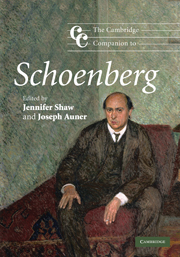Book contents
- Frontmatter
- 1 Introduction
- Part I Schoenberg's early years
- 2 Schoenberg's lieder
- 3 Schoenberg and the tradition of chamber music for strings
- 4 Two early Schoenberg songs: monotonality, multitonality, and schwebende Tonalität
- 5 Arnold Schoenberg and Richard Strauss
- Part II Schoenberg, modernism, and modernity
- Part III Schoenberg between the World Wars
- Part IV Schoenberg's American years
- Notes
- Select bibliography
- Index
3 - Schoenberg and the tradition of chamber music for strings
from Part I - Schoenberg's early years
Published online by Cambridge University Press: 28 September 2011
- Frontmatter
- 1 Introduction
- Part I Schoenberg's early years
- 2 Schoenberg's lieder
- 3 Schoenberg and the tradition of chamber music for strings
- 4 Two early Schoenberg songs: monotonality, multitonality, and schwebende Tonalität
- 5 Arnold Schoenberg and Richard Strauss
- Part II Schoenberg, modernism, and modernity
- Part III Schoenberg between the World Wars
- Part IV Schoenberg's American years
- Notes
- Select bibliography
- Index
Summary
Chamber music was as central to Schoenberg's life's work as it had been for the great Viennese composers before him: Haydn, Mozart, Beethoven, Schubert, and the central model of Schoenberg's youth – Brahms. While a significant proportion of Schoenberg's chamber works was composed for idiosyncratic ensembles (including Herzgewächse, Op. 20; Pierrot lunaire, Op. 21; Serenade, Op. 24; Suite, Op. 29; and Ode to Napoleon, Op. 41), it is through the chamber music for strings that Schoenberg most directly engages, continues, and transforms a tradition that was at the very core of his self-identity as a composer. Moreover, the genre of the string quartet in particular continued to develop in extraordinary ways throughout the second half of the twentieth century on into our own time. The string quartets of the Second Viennese School – Schoenberg, Berg, and Webern – along with those of Bela Bartók were the chief inspiration for these remarkable developments.
Schoenberg's chamber music for strings consists of seven works, the String Quartet in D major (1897), the string sextet Verklärte Nacht, Op. 4, the four string quartets with opus numbers (Opp. 7, 10, 30, 37), and the String Trio, Op. 45. In addition to the sextet, quartets, and trio, there is the Phantasy for violin and piano, Op. 47. (Schoenberg also composed a Scherzo for String Quartet, originally the second movement for the 1897 String Quartet in D major). The chamber music for strings spans nearly fifty years, including all of Schoenberg’s compositional periods: the early tonal music inspired principally by Brahms; the highly chromatic tonality of his first maturity; the contextual “atonality” of his second period; the twelve-tone music from the Weimar years; and the late twelve-tone music composed after his emigration to the United States.
- Type
- Chapter
- Information
- The Cambridge Companion to Schoenberg , pp. 30 - 52Publisher: Cambridge University PressPrint publication year: 2010

